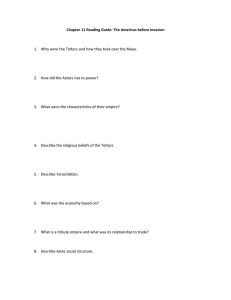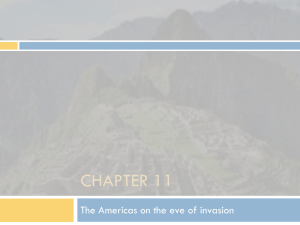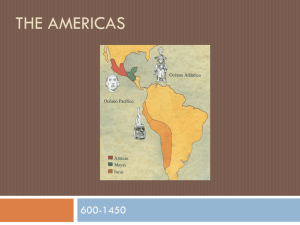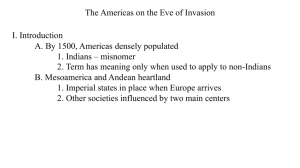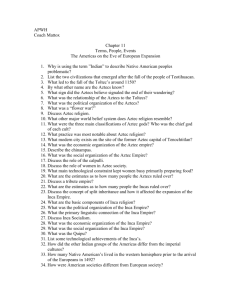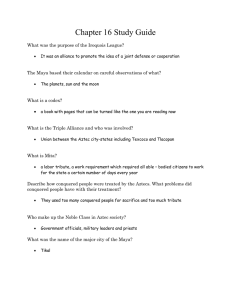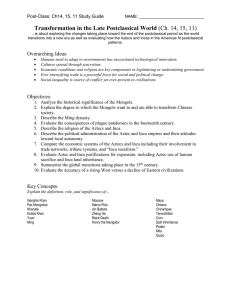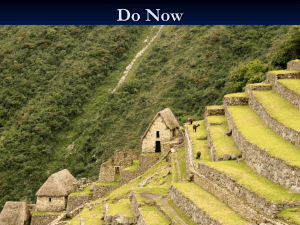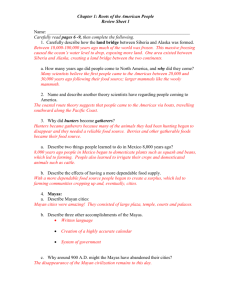Document 17605510
advertisement
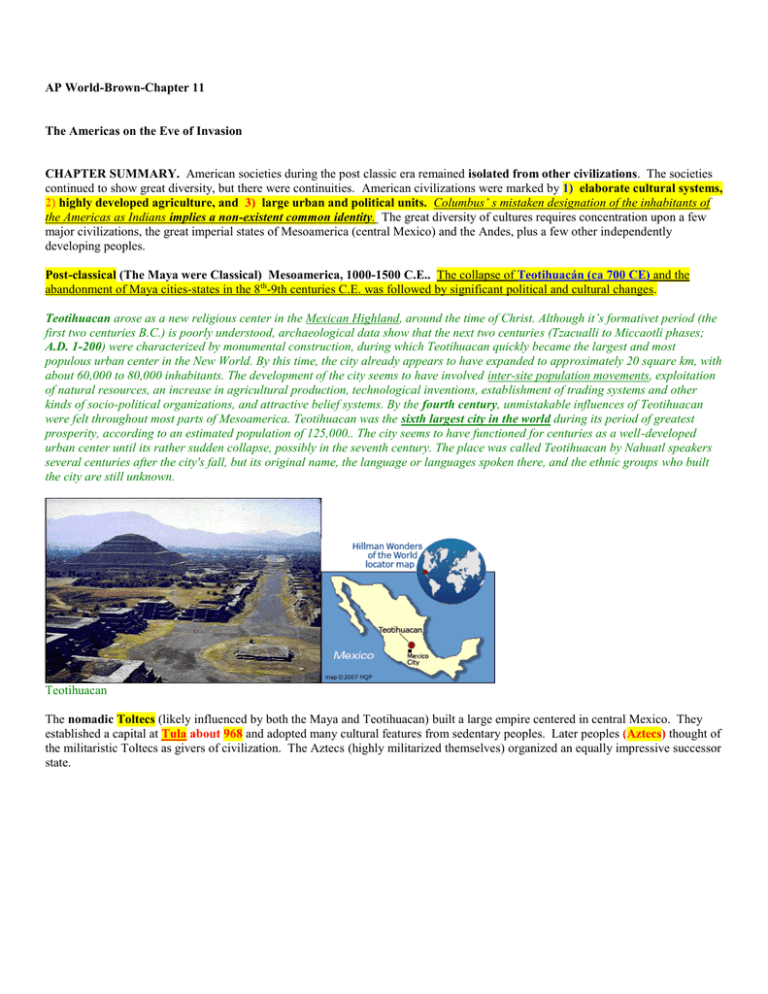
AP World-Brown-Chapter 11 The Americas on the Eve of Invasion CHAPTER SUMMARY. American societies during the post classic era remained isolated from other civilizations. The societies continued to show great diversity, but there were continuities. American civilizations were marked by 1) elaborate cultural systems, 2) highly developed agriculture, and 3) large urban and political units. Columbus’ s mistaken designation of the inhabitants of the Americas as Indians implies a non-existent common identity. The great diversity of cultures requires concentration upon a few major civilizations, the great imperial states of Mesoamerica (central Mexico) and the Andes, plus a few other independently developing peoples. Post-classical (The Maya were Classical) Mesoamerica, 1000-1500 C.E.. The collapse of Teotihuacán (ca 700 CE) and the abandonment of Maya cities-states in the 8th-9th centuries C.E. was followed by significant political and cultural changes. Teotihuacan arose as a new religious center in the Mexican Highland, around the time of Christ. Although it’s formativet period (the first two centuries B.C.) is poorly understood, archaeological data show that the next two centuries (Tzacualli to Miccaotli phases; A.D. 1-200) were characterized by monumental construction, during which Teotihuacan quickly became the largest and most populous urban center in the New World. By this time, the city already appears to have expanded to approximately 20 square km, with about 60,000 to 80,000 inhabitants. The development of the city seems to have involved inter-site population movements, exploitation of natural resources, an increase in agricultural production, technological inventions, establishment of trading systems and other kinds of socio-political organizations, and attractive belief systems. By the fourth century, unmistakable influences of Teotihuacan were felt throughout most parts of Mesoamerica. Teotihuacan was the sixth largest city in the world during its period of greatest prosperity, according to an estimated population of 125,000.. The city seems to have functioned for centuries as a well-developed urban center until its rather sudden collapse, possibly in the seventh century. The place was called Teotihuacan by Nahuatl speakers several centuries after the city's fall, but its original name, the language or languages spoken there, and the ethnic groups who built the city are still unknown. Teotihuacan The nomadic Toltecs (likely influenced by both the Maya and Teotihuacan) built a large empire centered in central Mexico. They established a capital at Tula about 968 and adopted many cultural features from sedentary peoples. Later peoples (Aztecs) thought of the militaristic Toltecs as givers of civilization. The Aztecs (highly militarized themselves) organized an equally impressive successor state. TIMELINE The Olmec - 1200 BCE- 300 CE-located in the saddle of the Yucatan Peninsula Who were the Olmecs? The Olmec were the first true civilization of the Americas lacking only complex writing and were the ancestors of the later cultures The Maya Empire & Civilisation - 300 – 1500'sCE-located throughout the Yucatan Peninsula Who were the Mayans? The Mayans empire covered Mexico, Guatemala, Belize, Honduras, and El Salvador. The Maya developed astronomy and hieroglyphic writing (one of only 5 original complex writing systems on earth) Mayan Codex (writing) The Toltec Empire & Civilisation - 900's – 1100'sCE-located in the Valley of Mexico Who were the Toltecs? The Nomadic and Warlike Toltecs finally settles and ruled Mexico and Guatemala from the 10th to the 12th century The Aztec Empire & Civilisation - 1100'S- 1500'SCE-located in the Valley of Mexico Who were the Aztecs? The Aztec rose to power in Mexico during the 12th and 13th centuries and remained in control until the arrival of the Spaniards in the 16th Century The Inca Empire & Civilisation - 1438 – 1535CE-located in the Andes Mountain Chain around Peru up and down Western S. America Who were the Incas? The empire of the Incas covered Peru, Bolivia, northern Argentina, Chile, and Ecuador. The amazing rise of the Incas was achieved in less than one hundred years and covered an area of nearly 400,000 square miles The Spanish Conquistadors - 1535CE The later civilizations of South America abruptly ended (due to disease but also terrible exploitation) after 1535 when the Spanish conquistadors seized control The Toltec Heritage. The Toltecs created a large empire reaching beyond central Mexico. Around 1000 CE they extended their rule to Yucatan and the former Mayan regions. Toltec commercial influence extended northward as far as the American southwest, and perhaps to Hopewell peoples of the Mississippi and Ohio valleys. Many cultural similarities exist, but no Mexican artifacts have been found. Palace of Quetzalcoatl The Aztec Rise to Power. Northern nomadic invasions probably caused the collapse of the Toltec empire around 1150. The center of population and political power shifted to the valley of Mexico and its large chain of lakes. A dense population used the water for agriculture, fishing, and transportation. The region became the cultural heartland of postclassical Mexico. It was divided politically into many small and competing units. The militant Aztecs (or Mexica) migrated to the region during the early 14th century and initially served the indigenous inhabitants as allies or mercenaries for the Toltecs. Around 1325 they founded the cities of Tenochtitlan and Tlatelolco (Large Commercial adjacent to Tenochtitlan) on lake islands. By 1434 the Aztecs had become the dominant regional power. Aztec trace their culture directly to the Toltecs Flag of Mexico The Aztec Social Contract. The Aztecs were transformed by the process of expansion and conquest from an association of clans to a stratified society under a powerful ruler. Central to the changes was Tlacaelel, an important official (person) serving rulers between 1427 and 1480. The Aztecs developed a self-image as a people chosen to serve the gods. The long-present religious practice of human sacrifice was greatly expanded. The military class had a central role as suppliers of war captives (flower people) for sacrifice. The rulers used sacrifice as an effective means political terror. By the rule of Moctezuma II the ruler, with civil and religious power, dominated the state. Aztecs dealt constantly with enemies and allies who might become potential enemies. Tlacaelel I (1397 – 1487) was the principal architect of the Aztec Triple Alliance and hence the Mexica (Aztec) empireTlacaelel recast or strengthened the concept of the Aztecs as a chosen people, elevated the tribal god/hero Huitzilopochtli to top of the pantheon of gods, and increased militarism. In tandem with this, Tlacaelel is said to have increased the level and prevalence of human sacrifice, particularly during a period of natural disasters that started in 1446. It is thought that it was during the reign of Moctezuma I, as an invention of Tlacaelel that the flower wars, in which the Aztecs fought Tlaxcala and other Nahuan city-states, were instigated. Religion and the Ideology of Conquest. In the Aztec religion little distinction was made between the world of the (gods and the natural) order. Hundreds of male and female gods representing rain, fire, etc., were worshipped. They can be arranged into three major divisions. The first included gods of fertility, the agricultural cycle, maize, and water they included Quetzalcoatl . The second group centered on creator deities: Tonatiuh, warrior god of the sun, and Tezcatlipoca, god of the night sky, were among the most powerful. The third division had the gods of warfare and sacrifice, among them Huitzilopochtli, the tribal patron. Huitzilopochtli became the paramount deity and was identified with the old sun god; he drew strength from the sacrifice of human lives. The Aztecs expanded the existing Mesoamerican practice of human sacrifice to an unprecedented scale. Symbolism and ritual, including ritual cannibalism, accompanied the sacrifices. The balance between sacrifice motivated by religion or terror is still under debate. The Aztecs had other religious concerns besides sacrifice. They had a complex mythology that explained the birth and history of the gods and their relation to humans. Religious symbolism infused all aspect of life. The Aztecs had a cyclical, fatalistic, view of history; they believed the world had been destroyed before and, despite the sacrifices, would be again. They also believed in their superiority over other humans as “chosen” people. Tenochtitlan, the Foundation of Heaven. The Aztec believed their capital to be a sacred space. The great metropolis of Tenochtitlan had a central zone of palaces and temples surrounded by residential districts and markets. Its design, craftsmanship, and architecture were outstanding. By 1519 the city covered five square miles and had 150,000 residents. The island city was connected to the lake shores by four causeways and was crisscrossed by canals. Each city ward was controlled by a kin group (calpulli) who maintained temples and civic buildings-these kin groups became less genetically based over time. Tribute and support came to the imperial city-state from allies and dependents. Feeding the People: The Economy of the Empire. Feeding the Aztec confederation depended both upon traditional agricultural forms and innovations. Conquered peoples lost land and gave food as tribute. In and around the lake the Aztecs developed a system of irrigated agriculture. They built chinampas, artificial floating islands, that permitted the harvesting of high-yield multiple yearly crops. Aztec peasant production and tribute supplied the basic foods. Clans (leading families in an area) in each community apportioned land between people, nobles, and temples. There were periodic markets for exchange. The great daily market at Tlatelolco (next to Tenochtitlan) was controlled by a merchant class (pochteca) which specialized in long-distance luxury item trade. The Aztecs had a state-controlled mixed economy: tribute, markets, commodity use, and distribution were highly regulated.-This was STATE CONTROLLED TRADE…. chinampas Evolution of Aztec Society in Transition. The society of the expanding Aztec empire became increasingly hierarchical. The Calpulli group organization did survive, but eventually other (different) social classes appeared. PROBLEM=Tribute from subject peoples was not enough to maintain the large Aztec population. Tenochtitlan Tenochtitlan Widening Social Gulf. By the 16th century (1500s) the seven original calpulli families had expanded from kinship groups to become residential groupings including neighbors, allies, and dependents. The calpulli performed vital local functions in distributing land and labor and maintaining temples and schools. During wars they organized military units. Calpulli were governed by councils of family heads, but all families were not equal. During Aztec expansion a class of nobility (pipiltin) eventually emerged from some privileged families of the most distinguished calpulli. (KNOW AZTEC SOCIAL CLASSES) These new nobles controlled the military and priesthood. Military virtues infused all society and were linked to the cult of sacrifice; they justified the nobility's predominance. Death in battle assured eternal life, a reward also going to women dying in childbirth. The social gap separating nobles from commoners widened. Social distinctions were formalized by giving the pipiltin special clothes and symbols of rank. The imperial family was the most distinguished of the pipiltin families. A new class of workers resembling serfs was created to serve on the nobility's private lands. They held a status above slaves. Other groups, scribes, artisans, and healers, constituted an intermediate middle social group in the larger cities. Long-distance merchants had their own calpulli group, but restrictions blocked their entry into the nobility. Overcoming Technological Constraints. Aztec women had a variety of roles. Peasant women helped in the fields, but their primary work was in the household; skill in weaving was highly esteemed. Grinding maize (corn) was ingredibly time consuming). Elder women trained young girls. Marriages were arranged between lineages, and female virginity was important. Polygamy existed only among the nobility; peasants were monogamous. Women certainly inherited and passed on property economically, but in political and social life they were subordinate to men. New World technology limited social development, especially for women, when compared to other cultures. Again, The absence of milling technology meant that women spent many hours daily in grinding maize by hand for household needs. The total Aztec population may have reached over 20 million. A Tribute System type of Empire. Each of the Aztec city-states was ruled by a speaker chosen from the nobility (Pipiltin). The ruler of Tenochtitlan, the Great Speaker, surpassed all others in wealth and power. He presided over an elaborate court. A prime minister, usually a close relative of the ruler, had tremendous power. There was a governing council, but it lacked real power. During the first 100 years of Aztec expansion a powerful nobility and emperor had taken over authority formerly held by calpulli. Military virtues became supreme as the state religion, and the desire for more tribute and captives for sacrifice, drove the Aztecs to further conquests. The empire was not integrated; defeated local rulers often remained in place as subordinate officials who hated the Aztecs but were forced to cooperate. They were left alone if tribute and labor obligations were met. Revolts against the exactions were ruthlessly suppressed. The Aztec system was successful because it aimed at political domination and not direct control. In the long run the growing social stresses created by the rise of the pipiltin and the terror and tribute imposed on subjects contributed to the empire's collapse. Most scholars accept the idea that the Aztecs could not have maintained their society for much longer even if the Spanish had not arrived to expidite the collapse In Depth: The "Troubling" Civilizations of the Americas. European concepts of civilization did not match with the practices of American Indians. Judging a civilization different from one’s own always is a complex proceeding. While some condemn Aztec sacrifice, others romanticize the Indian past. The arguments over the possible existence of Inca socialism or about the nature of Aztec religion are examples. Moral judgment is probably inevitable, but students of history must strive to understand a people’s practices in the context of their own time and culture. THE TWANTINSUYU (THE INCA) Twantinsuyu: World of the Incas. During the period following the disintegration of the states of Tihuanaco and Huari (c.550-1000 C.E.) smaller regional states exercised power in the Andes (very much like the historic tendency of regionalism in early India, Europe, and Japan). Some of them were centers of agricultural activity and population density. The considerable warfare among the states was similar to the post-Toltec period of fighting in Mesoamerica. The state of Chimor (900-1465) emerged as most powerful, controlling most of the north coast of Peru. But, after 1300 the Inca developed a new civilization above the clowds The Incas developed a large lung capacity and since there was high elevation, of course it would be cold, so their bodies grew stout and short, where the body warmth would be compacted inside of them. The Inca Rise to Power. In the southern Andean highlands many groups fought for supremacy. Quechua- speaking clans (ayllus) around Cuzco won control of territory formerly under Huari in Peru. By 1438, under their leader Pachacuti, they began campaigns ending with their control of the region. Pachacuti's son, Topac Yupanqui (1471-1493), conquered Chimor and extended Inca rule into Ecuador and Chile. Huayna Capac (1493-1527) consolidated the conquests; by his death the Inca empire - Twantinsuyu stretched from Colombia to Chile, and eastward to Bolivia and Argentina. From 9 to 13 million people were under Inca rule. Inca Empire Conquest and Religion. The Inca had other reasons for expansion besides the desire for economic gain and political power. They adopted from Chimor the practice of "split inheritance": all of a ruler’s political power went to the successor, while all wealth and land passed to male descendants for the eternal support of the cult of the dead ruler's mummy. The system created a justification for endless expansion. Inca political and social life was infused with religious meaning. The sun (Inte) was the highest deity; the ruler (Inca) was the god’s representative on earth. The Temple of the Sun at Cuzco was the center of state religion. The sun cult spread throughout the empire, but the worship of local gods continued. Popular belief was based upon a profound animism that endowed natural phenomena with spiritual power. Prayers and sacrifices were offered at holy shrines (huacas), which were organized into groupings under the authority of ayllus (clans). The temples were served by priests and women priestesses dedicated to preparing the sacrifices and managing important festivals and celebrations. Inca women were far more active in Religious leadership than in the Aztec World The Incas were polytheists (they worshipped several different gods). The most important god was Inti, the sun god. The Incas also worshipped Quilla the moon goddess, wife of the sun. They also worshipped Illapa god of thunder, who controlled the rain. The Incas had a host of priests and priestesses to serve their gods in temples throughout the empire. Priests were also surgeons who performed simple operations. Patients chewed coca leaves to dull the pain. Priests bit the heads of a type of ant and used the jaws as clips to close wounds. The Incas sometimes practiced human sacrifice but it was rare. The sacred city of the Inca was Machu Picchu Incan Mummified girl The Techniques of Inca Imperial Rule. The Inca (King), considered virtually a god, ruled the empire from Cuzco. It also was the site of the major temple. The empire was divided into four provinces, each under a governor. The Incas had a bureaucracy in which most of the nobility served. Local conquered rulers (curacas) continued in office in return for loyalty. They were exempt from tribute and received labor or produce from their subjects. Their sons were educated in Cuzco. This system was similar to Imperial Rome. The Quechua language, the use of colonists (mitmaqs), and the forced transfer of peoples (forced migration) were important techniques for integrating the empire. These were the keys to unity and Inca identity (language, resettlement, aspects of religion, some local autonomy, and roads) A complex system of roads, bridges, and causeways, with way stations (tambos) and storehouses, helped military movement. Conquered peoples supplied land and labor. They were integrated into the Inca military and received rewards from new conquests. The Inca state organized building and irrigation projects beyond the capabilities of subject peoples. In return tribute and loyalty were required. All local resources were taken and redistributed: there were lands for the people, the state, and religion. Labor on state and religious land was demanded rather than tribute in kind. This is known today as Incan Socialism. All Women had supply woven cloth for the court and religious use. Some women were taken as concubines for the Inca or as temple servants. Each community was controlled by the ayllus (clans) and aimed at self-sufficiency. Women worked in the household, wove cloth, and aided in agriculture. Since Andean people recognized parallel descent, property passed in both lines. Even though an ideology of complimentary genders was strong, the emphasis on military virtue made men dominant. The idea of gender cooperation was reflected in cosmology. Gods and goddesses were usually dual counterparts (masculine and feminine) and were venerated by both sexes, though women had a special feeling for the moon and the fertility goddesses of the earth and corn. The ruler's senior wife was a link to the moon Most males were peasants and herders….. Still, male power was exercised within the empire concerning the selection of women for state and temple purposes. The integration of imperial policy with regional diversity was a great political achievement that happened in a century. Reciprocity between the state and local community allowed the empire to function efficiently. Within the system the Inca nobility had many privileges and were distinguished by dress and custom. There was no distinct merchant class as in the Aztec world because of the emphasis on socialism, self-sufficiency (with little trade), and state management of the economy. The state remained strong until it lost control of its subject peoples and government mechanisms. Royal multiple marriages used to forge alliances eventually created rival claimants for power and civil war. Two brothers (Huáscar and Atahualpa will fight a very destructive civil war for the Inca crown. Atahualpa will win but be immediately captured by the Spanish under Pizarro and ransomed……Atahualpa will be the last Inca ruler (excluding rebellions)………… …..Atahualpa promised to fill a large room with gold and silver to buy his freedom from the Spanish….He did so and Pizarro had him executed anyway THE GREAT INCA REBELLION In August 1536, some 50,000 warriors marched on Lima under the command of Manco Inca’s most valiant general, Quizo Yupanqui, with orders to kill every Spaniard in the newly founded capital. How the Spanish survived is still a mystery but it is assumed the Spanish got some allies of the Inca to switch sides……..The was the last significant power the Inca held against the Spanish Inca Cultural Achievements. The Inca produced beautiful pottery and cloth. Their metallurgy was among the most advanced of the Americas. They lacked the wheel and a writing system, instead using knotted strings (quipu) for accounts and enumeration. The peak of Inca genius was really in statecraft and architecture. They constructed great stone buildings, agricultural terraces, irrigation projects, and road systems. Quipu Comparing Incas and Aztecs. SIMILARITIES---1----Both empires were based upon the long development of civilizations that preceded them. 2----They excelled in imperial and military organization. 3----The two were based upon intensive agriculture organized by the state; goods were redistributed to groups or social classes. 4---The Aztecs and Incas transformed an older kinship system into a hierarchical one where the nobility predominated. 5---In both the nobility was the personnel of the state. 6---Although the Incas tried to integrate their empire as a unit, both empires recognized local ethnic groups and political leaders in return for loyalty (although the Aztecs employed more terrorism). 7-The Aztecs and Incas found their military power less effective against nomadic frontier people; 8-their empires were based on conquest and exploitation of sedentary peoples. There were considerable differences between Incas and Aztecs, many of them the result of climate and geography. 1) Trade and markets were more developed among the Aztecs. Other differences were present in 2)metallurgy, 3) writing systems, and 4) social definition and hierarchy. 5) Economically the Inca were extremely socialistic while the Aztec amassed food and labor through a forced tribute system. In the context of world civilizations both can be viewed as variations of similar patterns, with sedentary agriculture as the most important factor. THE OTHER INDIANS. Mesoamerican and Andean civilizations were high points of Indian cultural development. The rest of the American continents were occupied by many peoples living in different ways. They can be grouped according to gradations based upon material culture and social complexity. The Incas shared many things with tribal peoples of the Amazon, including clan divisions. The diversity of ancient America forces a reconsideration of patterns of human development dependent on examples from other civilizations. Social complexity based upon agriculture was not necessary for fishing and hunting-gathering societies of the northwest United States and British Columbia: they developed hierarchical societies. In Colorado and South America, Indians practiced irrigated agriculture but did not develop states. How Many Indians? Arguments about the population of the Americas have been going on for a long time. Most scholars now agree that Mesoamerica and the Andes had the largest populations (see table 17.1). If we accept a total of 67 million, in a world population of about 500 million (see table 17.2), Americans clearly were a major segment of humanity. Differing Cultural Patterns. There were major cultural patterns in the Americas outside of the main civilization areas. They shared features with both the Andes and Mesoamerica, perhaps serving at times as points of cultural and material change between the two regions. In central Colombia the Muisca and Tairona peoples had large, sedentary agriculture-based chiefdoms that shared many resemblances with other similarly based states. Along the Amazon the rich aquatic environment supported complex, populous chiefdoms; other large populations dependent upon agriculture were present on Caribbean islands. Such societies resembled societies in Polynesia. By 1500 agriculture was widely diffused throughout the Americas. Some societies combined it with hunting-gathering and fishing. Slash-and-burn farming caused frequent movement in societies often not possessing large numbers, strong class divisions, or craft specialization. There were few nomadic herders. In 1500 about 200 languages were spoken in North America. By then the towns of the Mississippi Mound Builders had been abandoned and only a few peoples maintained their patterns. In the southwest the Anasazi and other cliff dwellers had moved to pueblos along the Rio Grande and practiced irrigated agriculture. Most other North American Indians were hunters and gatherers, sometimes also cultivating crops. In rich environments complex social organization might develop without agriculture. There were sharp differences with contemporary European and Asian societies. Most Indian societies were kin-based, with communal ownership of resources. Material wealth was not important for social rank. Women were subordinate to men, but in many societies held important political and social roles. They had a central role in crop production. Indians, unlike Europeans and Asians, viewed themselves as part of the ecological system, not in control of it. Conclusion: American Indian Diversity in World Context. Two great imperial systems had been created in Mesoamerica and the Andes. By the close of the 15th century these militaristic states were fragile, weakened by internal strains and technological inferiority. American societies ranged from the Aztec-Inca great civilizations to small bands of hunters. The continued; evolution of all Indian societies was disastrously disrupted by European invasions beginning in 1492. KEY TERMS Indian: misnomer created by Columbus when referring to indigenous New World peoples; implies social and ethnic commonalty that did not exist among Native Americans; still used to describe Native Americans. Topac Yupanqui: Inca ruler (1471-1493); extended his father’s conquests; seized the northern coastal kingdom of Chimor and pushed into Equador.. Huayna Capac: Inca ruler (1493-1527); brought the empire to its greatest extent. Toltecs: nomadic peoples from beyond the northern frontier of sedentary agriculture in Mesoamerica; established capital at Tula following migration into central Mesoamerican plateau; strongly militaristic ethic, including cult of human sacrifice. split inheritance: Inca practice of ruler descent; all titles and political power went to successor, but wealth and land remained in hands of male descendants for support of dead Inca's mummy. Aztecs: the Mexica; one of the nomadic tribes that penetrated into the sedentary zone of the Mesoamerican plateau after the fall of the Toltecs; established empire after 1325 around shores of Lake Texcoco. Temple of the Sun: Inca religious center at Cuzco; center of state religion; held mummies of past Incas. Tenochtitlan: founded ca. 1325 on a marshy island in Lake Texcoco; became center of Aztec power. pipiltin: nobility in Aztec society; formed by intermarriage of Aztecs with peoples tracing lineage back to the Toltecs. Tlacaelel: advisor to Aztec rulers (1427-1480; had histories of Mexico rewritten; expanded cult of human sacrifice as effective means of political terror. Huitcilopochtli: Aztec tribal patron god; central figure of human sacrifice and warfare; identified with old sun god. calpulli: clans in Aztec society; evolved into residential groupings that distributed land and provided labor and warriors. chinampas: beds of aquatic weeds, mud, earth placed in frames made of cane and rooted in lakes to create "floating islands"; system of irrigated agriculture used by Aztecs. Curacas: local rulers who the Inca left in office in return for loyalty. mitmac: Inca colonists in new regions; could be Quechua speakers used to pacify new conquest or conquered population moved to new homes. tambos: waystations used by Incas as inns and storehouses; supply centers for Inca armies; relay points for system of runners used to carry messages. mita: labor extracted for lands assigned to the state and the religion; all communities were expected to contribute; an essential part of Inca control. quipu: system of knotted strings utilized by the Incas in place of a writing system; could contain numerical and other types of information for censuses and financial records. CLASS DISCUSSION QUESTIONS 1. What was the relationship of the Aztecs to the Toltecs? pochteca: merchant class in Aztec society; specialized in long-distance trade in luxury items. Inca socialism: an interpretation describing Inca society as a type of utopia; image of the Inca empire as a carefully organized system in which every community collectively contributed to the whole. Twantinsuyu: Inca word for their empire; region from Colombia to Chile and eastward into Bolivia and Argentina. 2. What was the political and economic organization of the Aztec empire? 3. What was the social organization of the Aztec empire? 4. What was the political and economic organization of the Inca empire? 5. What was the social organization of the Inca empire? Inca: group of clans (ayllu) centered at Cuzco; created an empire in the Andes during the 15th century; also title of the ruler. 6. How did the other Indian groups of the Americas differ from the imperial cultures? Pachacuti: Inca ruler (1438-1471); began the military campaigns that marked the creation of an Inca empire. 7. How were American societies different from European society? LECTURE SUGGESTIONS 1. Compare and contrast the imperial civilizations of the Andes and Mesoamerica. Both were based on the long development of preceding civilizations. They represented the success of imperial and military organization, and of extensive agricultural systems controlled by the state. Older kinship groups had been transformed into a hierarchical system and the nobility became state personnel. Both recognized local ethnic groups and-political leaders in return for recognition of sovereignty. There were similarities in belief systems and cosmology. Each power had limited success against nomadic people on their frontiers. Differences came from climate and geography: the Andes region was more mountainous and isolated. Trade, markets, and a merchant class were present in each, although they were more developed among the Aztecs. The Incas lacked a writing system, but had greater metallurgical skills. The Aztecs made extensive use of human sacrifice. 2. Discuss the similarities and differences between the civilizations of the Americas and Polynesia. Among the similarities were a strong emphasis on clan-based societies, a division of resources according to clans, and lack of writing systems (at least among the Inca), strongly animistic religions, emphasis on militaries (at least among the Maori), lack of technological sophistication, absence of large mammals, lack of pastoral nomadism, and the practice of human sacrifice and ritual cannibalism. Among the differences the Polynesians lacked the following elements present in the Americas: imperial systems and monumental architecture. In the Americas the civilizations were much larger and had a higher population density. THE INSTRUCTOR'S TOOL KIT Map References Danzer, Discovering World History through Maps and Views Source Maps: S27-S28. Reference Maps: R22-R23. Audio Cassettes Pre-Columbian Instruments. Folkways FE 4177, (presents the sounds of authentic Aztec instruments taken from tombs). Traditional Music of Peru, rec. by Babs Brown and Samuel Marti, c. 1956. Folkways, FE 4456 Documents Bartoleme de Las Casas, Apologetic History of the Indies. In Peter Stearns, op. cit. Tribute Under the Aztecs In Kishlansky, op. cit. Video/Film The Incas Remembered. Filmic Archives Worlds Found and Lost. Films for the Humanities and Sciences, BN-2981 Archive of the New World. Films for the Humanities and Sciences, BN2415
